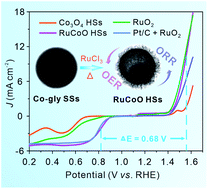Synergetic electronic modulation and nanostructure engineering of heterostructured RuO2/Co3O4 as advanced bifunctional electrocatalyst for zinc–air batteries†
Abstract
Exploring high-performance bifunctional electrocatalysts for air electrode reactions is significant for Zn–air batteries (ZABs). Herein, synergistic electronic modulation and nanostructure engineering are realized by a facile template-engaged synthesis of hierarchical RuO2/Co3O4 hollow spheres. Density functional theory (DFT) calculations are first conducted to disclose that the formation of heterostructured RuO2/Co3O4 can facilitate charge transport and optimize the adsorption of oxygen intermediates, enabling promising bifunctional activity for the oxygen evolution reaction (OER) and oxygen reduction reaction (ORR). Inspired by DFT predictions, the optimized ultrathin nanosheet-assembled RuO2/Co3O4 hollow spheres (RuCoO HSs) are synthesized. As expected, outstanding bifunctional electrocatalytic performance is demonstrated by RuCoO HSs. The OER overpotential of RuCoO HSs at 10 mA cm−2 is only 260 mV and the ORR half-wave potential is 0.81 V in 0.1 M KOH, corresponding to an ultralow potential gap of 0.68 V. More importantly, when evaluated as an air-electrode electrocatalyst, aqueous and flexible solid-state rechargeable ZABs with RuCoO HSs outperform commercial Pt/C + RuO2 based ZABs.



 Please wait while we load your content...
Please wait while we load your content...